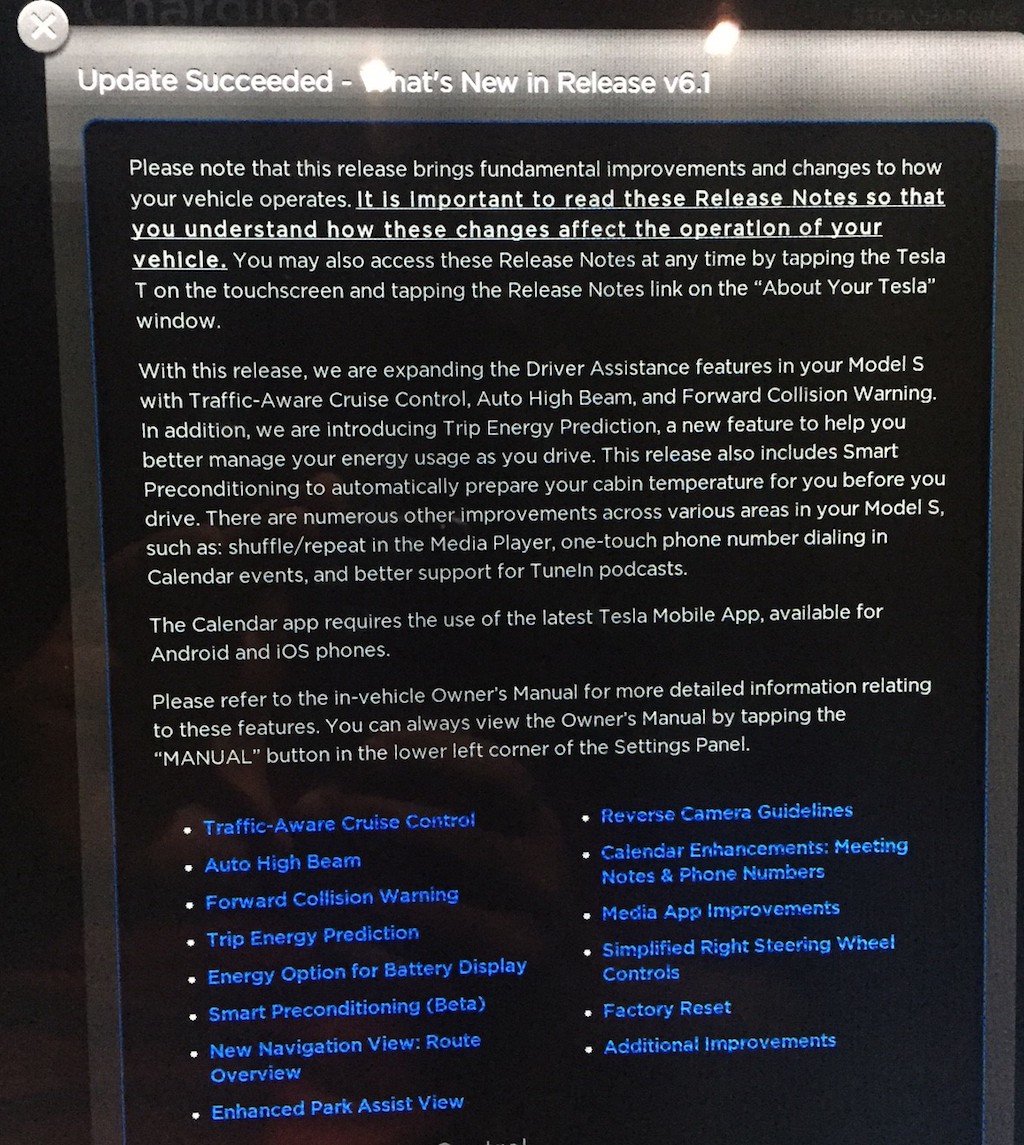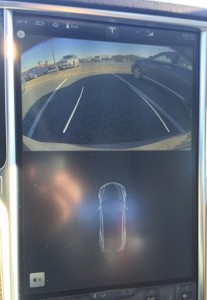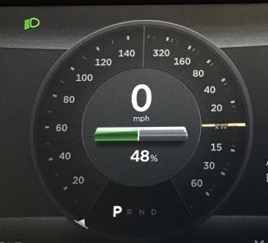News
Tesla Firmware 6.1: Range, Routes and Parking Aid

Following the review of Firmware 6.1’s Trip Energy Prediction roll out I’ll be taking a deeper look at some of the other major features that came bundled with this version such as navigation routing and the reverse camera parking aid.
Range Display: Battery %
The Model S displays battery range based on a rated or ideal measurement as determined by the methodology in which the US EPA measures electric vehicle range.
This range always seems to be a hot topic of discussion amongst owners since, almost always, the actual mileage achieved is lower than what’s displayed on the car’s dash. This is especially true during the cold New England winter months when 265 miles of rated range turns out to be closer to 160 miles of actual range due to the effects of winter driving.
The grim reality is that range based on distance (mi/km) will vary depending on how you drive, the terrain you drive on and the environmental conditions during that time.
Tesla Firmware 6.1 solves this issue by giving drivers the ability to replace the display of range with the percentage of battery life remaining. Sure there’s the color-coded battery indicator but being able to see an actual value makes it much more relatable. On top of that the amount of battery remaining lines up nicely to the energy graph displayed through the Trip Energy Prediction feature.
Using this new way of measuring your range takes some getting used to but after a week of using it I kind of like it. It certainly beats using a rated range display that ends up being off by 40-50% during the winter months.
Route Overview
 Tesla Firmware 6.1 also adds a new view for trip routing. A “Route Overview” option allows you to visualize your route using a north up view but with the ability to automatically zoom in as you approach your destination. There’s no need to manually pinch zoom anymore..
Tesla Firmware 6.1 also adds a new view for trip routing. A “Route Overview” option allows you to visualize your route using a north up view but with the ability to automatically zoom in as you approach your destination. There’s no need to manually pinch zoom anymore..
Enhanced Park Assist and Camera Guidelines
 I’m lumping these two features together but also keeping in mind that Park Assist is limited to those with the parking assist package.
I’m lumping these two features together but also keeping in mind that Park Assist is limited to those with the parking assist package.
With this new update putting the Model S in reverse will display both front and rear parking sensors making parallel parking and backing into tight spots that much easier. You also have the ability to manually trigger Park Assist as long as the car is traveling below 5mph. This is a great addition since it provides visibility for all four corners of the Model S.
Tesla finally put the rumors of having an inadequate graphics engine, that supposedly prevented the ability to render parking lines, to rest with the addition of the reverse camera guidelines.
I never had rear camera guidelines on any of my previous cars so this feature wasn’t on my wish list and I never really understood why so many people wanted them. Now that I have them I can see how it would be hard to ever go back to a car without them.
Rear camera guidelines was the #1 requested feature for years and Tesla has delivered!
Summarizing the feature, the Model S will overlay lines on the screen to indicate the path of travel when backing up. These lines move with your steering wheel and apparently the lines will change colors to ensure maximum contrast and visibility depending on the background. Here’s a video of it in action.
Summary
Tesla outdid itself with this the release of Firmware 6.1. It introduces a solid list of big features and improvements around range, routing displays and parking assistance. Combine this with the new feature to dynamically calculate range based on terrain and driving behavior, this is one of the best updates to date.
Stay tuned as I review some of the other enhancements that came bundled with this version.

Elon Musk
Elon Musk and Tesla AI Director share insights after empty driver seat Robotaxi rides
The executives’ unoccupied tests hint at the rapid progress of Tesla’s unsupervised Robotaxi efforts.

Tesla CEO Elon Musk and AI Director Ashok Elluswamy celebrated Christmas Eve by sharing personal experiences with Robotaxi vehicles that had no safety monitor or occupant in the driver’s seat. Musk described the system’s “perfect driving” around Austin, while Elluswamy posted video from the back seat, calling it “an amazing experience.”
The executives’ unoccupied tests hint at the rapid progress of Tesla’s unsupervised Robotaxi efforts.
Elon and Ashok’s firsthand Robotaxi insights
Prior to Musk and the Tesla AI Director’s posts, sightings of unmanned Teslas navigating public roads were widely shared on social media. One such vehicle was spotted in Austin, Texas, which Elon Musk acknowleged by stating that “Testing is underway with no occupants in the car.”
Based on his Christmas Eve post, Musk seemed to have tested an unmanned Tesla himself. “A Tesla with no safety monitor in the car and me sitting in the passenger seat took me all around Austin on Sunday with perfect driving,” Musk wrote in his post.
Elluswamy responded with a 2-minute video showing himself in the rear of an unmanned Tesla. The video featured the vehicle’s empty front seats, as well as its smooth handling through real-world traffic. He captioned his video with the words, “It’s an amazing experience!”
Towards Unsupervised operations
During an xAI Hackathon earlier this month, Elon Musk mentioned that Tesla owed be removing Safety Monitors from its Robotaxis in Austin in just three weeks. “Unsupervised is pretty much solved at this point. So there will be Tesla Robotaxis operating in Austin with no one in them. Not even anyone in the passenger seat in about three weeks,” he said. Musk echoed similar estimates at the 2025 Annual Shareholder Meeting and the Q3 2025 earnings call.
Considering the insights that were posted Musk and Elluswamy, it does appear that Tesla is working hard towards operating its Robotaxis with no safety monitors. This is quite impressive considering that the service was launched just earlier this year.
Elon Musk
Starlink passes 9 million active customers just weeks after hitting 8 million
The milestone highlights the accelerating growth of Starlink, which has now been adding over 20,000 new users per day.

SpaceX’s Starlink satellite internet service has continued its rapid global expansion, surpassing 9 million active customers just weeks after crossing the 8 million mark.
The milestone highlights the accelerating growth of Starlink, which has now been adding over 20,000 new users per day.
9 million customers
In a post on X, SpaceX stated that Starlink now serves over 9 million active users across 155 countries, territories, and markets. The company reached 8 million customers in early November, meaning it added roughly 1 million subscribers in under seven weeks, or about 21,275 new users on average per day.
“Starlink is connecting more than 9M active customers with high-speed internet across 155 countries, territories, and many other markets,” Starlink wrote in a post on its official X account. SpaceX President Gwynne Shotwell also celebrated the milestone on X. “A huge thank you to all of our customers and congrats to the Starlink team for such an incredible product,” she wrote.
That growth rate reflects both rising demand for broadband in underserved regions and Starlink’s expanding satellite constellation, which now includes more than 9,000 low-Earth-orbit satellites designed to deliver high-speed, low-latency internet worldwide.
Starlink’s momentum
Starlink’s momentum has been building up. SpaceX reported 4.6 million Starlink customers in December 2024, followed by 7 million by August 2025, and 8 million customers in November. Independent data also suggests Starlink usage is rising sharply, with Cloudflare reporting that global web traffic from Starlink users more than doubled in 2025, as noted in an Insider report.
Starlink’s momentum is increasingly tied to SpaceX’s broader financial outlook. Elon Musk has said the satellite network is “by far” the company’s largest revenue driver, and reports suggest SpaceX may be positioning itself for an initial public offering as soon as next year, with valuations estimated as high as $1.5 trillion. Musk has also suggested in the past that Starlink could have its own IPO in the future.
News
NVIDIA Director of Robotics: Tesla FSD v14 is the first AI to pass the “Physical Turing Test”
After testing FSD v14, Fan stated that his experience with FSD felt magical at first, but it soon started to feel like a routine.

NVIDIA Director of Robotics Jim Fan has praised Tesla’s Full Self-Driving (Supervised) v14 as the first AI to pass what he described as a “Physical Turing Test.”
After testing FSD v14, Fan stated that his experience with FSD felt magical at first, but it soon started to feel like a routine. And just like smartphones today, removing it now would “actively hurt.”
Jim Fan’s hands-on FSD v14 impressions
Fan, a leading researcher in embodied AI who is currently solving Physical AI at NVIDIA and spearheading the company’s Project GR00T initiative, noted that he actually was late to the Tesla game. He was, however, one of the first to try out FSD v14.
“I was very late to own a Tesla but among the earliest to try out FSD v14. It’s perhaps the first time I experience an AI that passes the Physical Turing Test: after a long day at work, you press a button, lay back, and couldn’t tell if a neural net or a human drove you home,” Fan wrote in a post on X.
Fan added: “Despite knowing exactly how robot learning works, I still find it magical watching the steering wheel turn by itself. First it feels surreal, next it becomes routine. Then, like the smartphone, taking it away actively hurts. This is how humanity gets rewired and glued to god-like technologies.”
The Physical Turing Test
The original Turing Test was conceived by Alan Turing in 1950, and it was aimed at determining if a machine could exhibit behavior that is equivalent to or indistinguishable from a human. By focusing on text-based conversations, the original Turing Test set a high bar for natural language processing and machine learning.
This test has been passed by today’s large language models. However, the capability to converse in a humanlike manner is a completely different challenge from performing real-world problem-solving or physical interactions. Thus, Fan introduced the Physical Turing Test, which challenges AI systems to demonstrate intelligence through physical actions.
Based on Fan’s comments, Tesla has demonstrated these intelligent physical actions with FSD v14. Elon Musk agreed with the NVIDIA executive, stating in a post on X that with FSD v14, “you can sense the sentience maturing.” Musk also praised Tesla AI, calling it the best “real-world AI” today.









